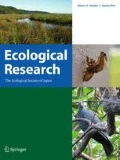Abstract
Climate condition is an important key affecting species presence, especially for reptiles. Precipitation and temperature are especially important environmental factors to consider. In the present study, I collected as many presence records as possible for seven lizard species from the Sistan region and analyzed them in relation to environmental variables using the maximum entropy algorithm. According to the analysis, temperature seasonality affected the distributions of three species (Eremias fasciata, Ophiomorus tridactylus, Teratoscincus bedriagai) and precipitation affected the presence of four species (Ablepharus pannonicus, Bunopus tuberculatus, Cyrtopodion scabrum, Trapelus agilis). The most important variable affecting E. fasciata and O.tridactylus (23% of contribution) is isothermality. For T. bedriagai, temperature seasonality was more important (32% contribution). Annual precipitation was the most highly contributed variable for A. pannonicus. Precipitation of the wettest month has a high contribution for the other species, representing 49, 48, and 54% for B. tuberculatus, C. scabrum and T. agilis, respectively.



Similar content being viewed by others
References
Anderson SC (1999) The lizards of Iran. Society for the Study of Amphibians and Reptiles, Ithaca, p 442
Araújo MB, Nogués-Bravo D, Diniz-Filho JAF, Haywood AM, Valdes PJ, Rahbek C (2008) Quaternary climate changes explain diversity among reptiles and amphibians. Ecography 31:8–15
Brown GW, Bennett AF, Potts JM (2008) Regional faunal decline–reptile occurrence in fragmented rural landscapes of south-eastern Australia. Wild Res 35:8–18
de Souza Muñoz ME, De Giovanni R, de Siqueira MF, Sutton T, Brewer P, Pereira RS, Canhos VP (2011) openModeller: a generic approach to species’ potential distribution modelling. GeoInformatica 15:111–135
Elith J, Phillips SJ, Hastie T, Dudík M, Chee YE, Yates CJ (2011) A statistical explanation of MaxEnt for ecologists. Divers Distribut 17:43–57
Greenville AC, Wardle GM, Nguyen V, Dickman CR (2016) Spatial and temporal synchrony in reptile population dynamics in variable environments. Oecologia 182:475–485
Hosseinian Yousefkhani SS, Ficetola GF, Rastegar-Pouyani N, Ananjeva NB, Rastegar-Pouyani E, Masroor R (2013) Environmental suitability and distribution of the Caucasian Rock Agama, Paralaudakia caucasia (Sauria: Agamidae) in western and central Asia. Asian Herpetol Res 4:207–213
Jiménez-Valverde A, Lobo JM (2007) Threshold criteria for conversion of probability of species presence to either–or presence–absence. Acta oecologica 31:361–369
Leviton AE, Anderson SC (1970) The Amphibians and reptiles of Afghanistan: a checklist and key to the Herpetofauna. California Academy of Sciences
Owen JG (1989) Patterns of herpetofaunal species richness: relation to temperature, precipitation, and variance in elevation. J Biogeo 20:141–150
Pausas JG, Austin MP (2001) Patterns of plant species richness in relation to different environments: an appraisal. J Veg Sci 12:153–166
Phillips SJ, Anderson RP, Schapire RE (2006) Maximum entropy modeling of species geographic distributions. Ecol Model 190:231–259
Qian H, Ricklefs RE (2008) Global concordance in diversity patterns of vascular plants and terrestrial vertebrates. Ecol let 11:547–553
Qian H, Wang X, Wang S, Li Y (2007) Environmental determinants of amphibian and reptile species richness in China. Ecography 30:471–482
Raes N, Ter Steege H (2007) A null-model for significance testing of presence-only species distribution models. Ecography 30:727–736
Toyosawa S, O’hUigin C, Figueroa F, Tichy H, Klein J (1998) Identification and characterization of amelogenin genes in monotremes, reptiles, and amphibians. Proc Nat Acad Sci 95:13056–13061
Whitney JW (2006) Geology, water, and wind in the lower Helmand Basin, southern Afghanistan (No. 2006-5182)
Acknowledgement
I thank Dr. Ann Paterson from Arkansas University who edited the early draft of manuscript.
Author information
Authors and Affiliations
Corresponding author
Electronic supplementary material
Below is the link to the electronic supplementary material.
About this article
Cite this article
Sanchooli, N. Ecological variables determining the presence of lizards in the Sistan region, Eastern Iran. Ecol Res 32, 995–999 (2017). https://doi.org/10.1007/s11284-017-1514-8
Received:
Accepted:
Published:
Issue Date:
DOI: https://doi.org/10.1007/s11284-017-1514-8




